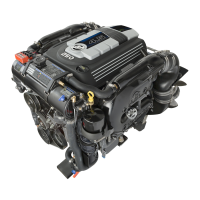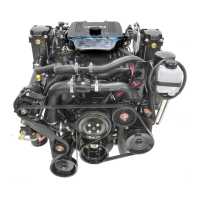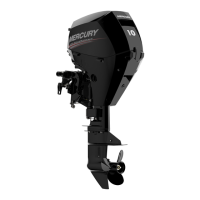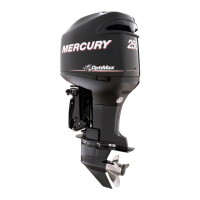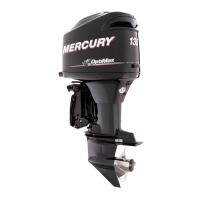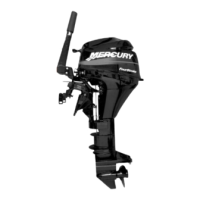17
90-10104R40
GB
gof20
234
1
ofp4
EMERGENCY STARTING
If the starter system fails, use the spare starter rope (provided) and follow this
procedure.
1 Shift outboard to neutral position.
WARNING
When using emergency starter rope to start engine, the start-in-gear pro-
tection provided by the remote control is inoperative. Make sure to set the
outboard gear shift into neutral to prevent outboard from starting in gear.
Sudden unexpected acceleration could result in serious injury or death.
2 Pry the fuel filter out of its mount.
3 Disconnect linkage from rewind starter assembly.
4 Remove three bolts and rewind starter assembly.
gof21
6-85
ofp23
EMERGENCY STARTING
5
Remote Control Models - Turn the ignition key or ON-OFF switch to ON
position.
6 Tie one end of the spare starter rope around screwdriver tool (provided) and
tie a knot in other end.
WARNING
To prevent getting an electrical shock, DO NOT touch any ignition com-
ponent, wiring, or spark plug wire when starting or running the engine.
WARNING
The exposed moving flywheel can cause serious injury. Keep your hands,
hair, clothing, tools, and other objects away from engine when starting
or running the engine.
Do not attempt to reinstall the rewind starter assembly or top cowl when
engine is running.
7 Place the starter rope knot into the flywheel notch and wind the rope clockwise
around the flywheel.
8 Pull the starter rope to start the engine.
oh
MAINTENANCE
oha4
OUTBOARD CARE
To keep your outboard in the best operating condition, it is important that your
outboard receive the periodic inspections and maintenance listed in the Inspection
and Maintenance Schedule. We urge you to keep it maintained properly to ensure
the safety of you and your passengers and retain its dependability.
WARNING
Neglected inspection and maintenance service of your outboard or at-
tempting to perform maintenance or repair on your outboard if you are
not familiar with the correct service and safety procedures could cause
personal injury, death, or product failure.
Record maintenance performed in Maintenance Log at the back of this book. Save
all maintenance work orders and receipts.
SELECTING REPLACEMENT PARTS FOR YOUR
OUTBOARD
We recommend using original Mercury Precision or Quicksilver replacement parts
and Genuine Lubricants.
WARNING
Using a replacement part that is inferior to the original part could result
in personal injury, death, or product failure.
a
c
d
b
e
oti8
EMISSION CERTIFICATION LABEL
An emission certification label, showing emission levels and engine specifications
directly related to emissions, is placed on the engine at time of manufacture.
a.Idle Speed
b.Engine Horsepower
c.Timing Specification
d.Recommended Spark Plug & Gap
e.Valve Clearance (if Applicable)
f. Family Number
g.Maximum Emission Output for
the Engine Family
h.Piston Displacement
i. Date of Manufacture
oti7
OWNER RESPONSIBILITY
The owner/operator is required to have engine maintenance performed to maintain
emission levels within prescribed certification standards.
The owner/operator is not to modify the engine in any manner that would alter the
horsepower or allow emissions levels to exceed their predetermined factory
specifications.
ohd31
INSPECTION AND MAINTENANCE SCHEDULE
Before Each Use
1. Check that lanyard stop switch stops the engine.
2. Visually inspect the fuel system for deterioration or leaks.
3. Check outboard for tightness on transom.
4. Check steering system for binding or loose components.
5. Remote Control Models - Visually check steering link rod fasteners for proper
tightness.
6. Check propeller blades for damage.
After Each Use
1. Flush out the outboard cooling system if operating in salt or polluted water.
(page 18)
2. Wash off all salt deposits and flush out the exhaust outlet of the propeller and
gear case with fresh water if operating in salt water.
Every 100 Hours of Use or Once yearly, Whichever occurs first
1. Lubricate all lubrication points. Lubricate more frequently when used in salt
water. (page 20)
2. Inspect and clean spark plugs. (page 19)
3. Check fuel line filter for contaminants. (pages 18)
4. Check carburetor adjustments, if required. (page 20)
5. Check corrosion control anodes. Check more frequently when used in salt
water. (page 19)
6. Drain and replace gear case lubricant. (page 21)
7. Lubricate splines on the drive shaft.*
8. Electric start models - Inspect battery. (page 18)
9. Remote control models - Check control cable adjustments. *
10.Remove engine deposits with Mercury Precision or Quicksilver Power Tune
Engine Cleaner.
11. Check tightness of bolts, nuts, and other fasteners.
12.Clean fuel tank pick up filter.
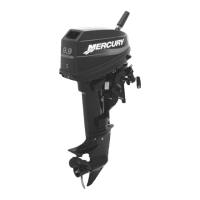
